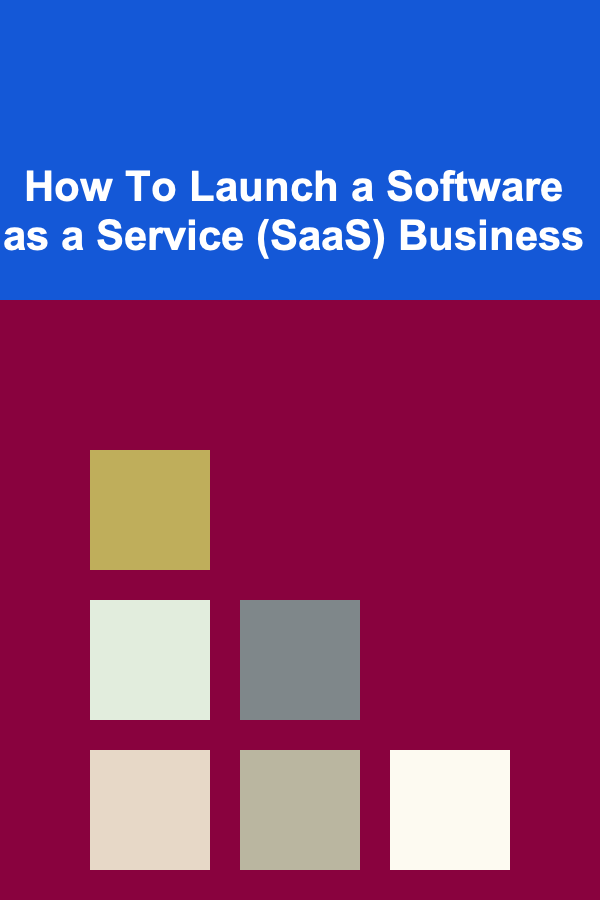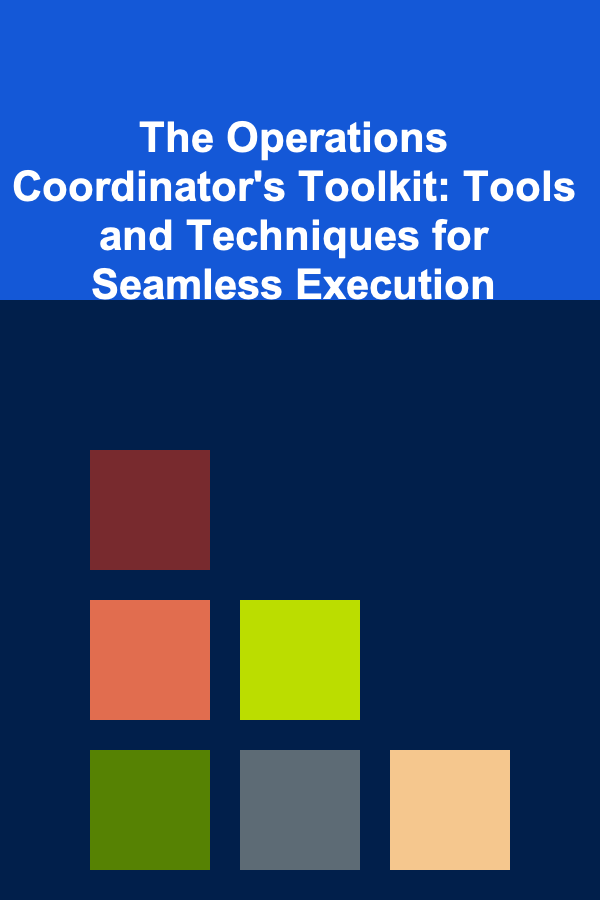
How To Launch a Software as a Service (SaaS) Business
ebook include PDF & Audio bundle (Micro Guide)
$12.99$6.99
Limited Time Offer! Order within the next:

Launching a Software as a Service (SaaS) business can be an exciting and rewarding endeavor. With the increasing demand for digital solutions across industries, SaaS has emerged as one of the most lucrative and scalable business models in the tech world. However, the path to successfully launching a SaaS business is complex, requiring a mix of technical expertise, strategic planning, market understanding, and execution.
In this comprehensive guide, we will walk through the key steps involved in launching a SaaS business, from conceptualizing your product to marketing it, managing customer relationships, and scaling it for long-term success. Whether you're an entrepreneur with a technical background or a non-technical founder with an idea, this guide will provide actionable insights to help you navigate the SaaS landscape.
Understand the SaaS Business Model
Before diving into the technicalities of SaaS development, it's essential to grasp the fundamentals of the SaaS business model. SaaS is a cloud-based software delivery model that allows customers to access applications via the internet, typically through a subscription. Instead of purchasing software outright, customers pay recurring fees to use the service, which can vary by the type of service, number of users, or features.
Some of the key features of SaaS include:
- Subscription-based pricing: Customers pay on a monthly or annual basis.
- Cloud hosting: Software is hosted on remote servers and accessible via the internet.
- Continuous updates and maintenance: SaaS providers handle software updates and improvements, which are made automatically.
- Scalability: SaaS solutions are highly scalable, catering to individual users or large enterprises.
The SaaS model provides several advantages over traditional software models, including lower upfront costs for customers, predictable revenue streams for businesses, and easy scalability. However, building a successful SaaS business requires more than just having a great idea. You need to address the unique challenges of creating a product that people want to use and are willing to pay for.
Identify a Market Need
The foundation of any successful SaaS business lies in identifying a market need. A successful product addresses a real pain point, solves a specific problem, and provides tangible value to its users. To launch a SaaS business, you must first conduct thorough research to understand your target market and the problems they face.
a. Conduct Market Research
Market research involves gathering insights into potential customers' needs, preferences, and behavior. This research will help you determine:
- Market size: Is there a large enough audience to sustain your SaaS business?
- Competition: Who are the competitors in your niche, and how can you differentiate yourself?
- Customer pain points: What problems are customers facing that your product can solve?
- Pricing: How much are customers willing to pay for your service?
You can gather market insights by:
- Conducting surveys: Reach out to potential customers with questions about their pain points and willingness to adopt a new solution.
- Analyzing competitors: Review similar SaaS products and assess their strengths, weaknesses, pricing, and customer feedback.
- Engaging with online communities: Join forums, social media groups, and professional networks where your target audience hangs out. Listen to their concerns and challenges.
- Interviewing industry experts: Speak with professionals who have experience in the field to gather insights and validate your ideas.
b. Validate Your Idea
Once you've identified a market need, it's crucial to validate your idea before building the product. Idea validation helps ensure that there is demand for your product, and you're not building something based on assumptions.
You can validate your idea by:
- Creating a landing page: Develop a simple website that explains your product idea and includes a call-to-action for interested users to sign up for more information or a waitlist.
- Running an MVP (Minimum Viable Product): Build a basic version of your product with just enough features to solve the core problem. Offer it to a select group of potential customers to gather feedback and iterate.
- Conducting user testing: Use focus groups or beta testing to gather real-world feedback from users who are willing to test your product.
Develop Your SaaS Product
With a validated idea and a clear understanding of your target market, the next step is to develop your SaaS product. The development process can be divided into several key stages:
a. Design Your Product
The design of your SaaS product is critical in shaping the user experience (UX) and user interface (UI). A well-designed product not only solves the problem but is easy to use, visually appealing, and intuitive.
Focus on:
- Simplicity: A clean, user-friendly interface will make it easier for users to adopt your product.
- Functionality: Ensure that the product addresses the core problem effectively and is reliable.
- Scalability: Your product should be able to scale as your user base grows, handling more data and traffic without performance degradation.
b. Build the Product
You can either build the product yourself if you have technical expertise or hire a development team. The development process typically includes:
- Frontend development: This is the part of the application that users interact with, including the user interface and experience.
- Backend development: This involves the server-side code, databases, and logic that power the SaaS platform.
- API development: If your product requires integration with third-party services or external tools, you'll need to build APIs (Application Programming Interfaces) to facilitate that communication.
- Security: Given that SaaS applications handle sensitive data, security is paramount. Ensure your product has encryption, data protection, and secure login methods.
c. Testing and Quality Assurance
Once the product is built, it's essential to conduct rigorous testing to ensure it works as expected. Testing includes:
- Functional testing: Ensure that all features work as intended and there are no bugs or errors.
- Performance testing: Test how the product performs under different conditions, such as high traffic or heavy data loads.
- Usability testing: Evaluate how easy it is for users to navigate and use the product.
- Security testing: Identify any potential vulnerabilities in your system and ensure data protection.
d. Create a Feedback Loop
After launching your MVP or beta version, continuously collect feedback from users to identify areas of improvement. Use feedback to iterate and improve your product over time.
Develop a Pricing Model
Pricing is one of the most critical factors in the success of your SaaS business. Your pricing model should reflect the value your product provides while also being competitive in the market. There are several pricing models that you can consider:
- Freemium: Offer a free version of your product with limited features and charge for premium features or advanced functionality.
- Tiered pricing: Create different pricing tiers based on the features and capabilities of your product. This allows customers to choose a plan that suits their needs.
- Per-user pricing: Charge based on the number of users who access the software.
- Usage-based pricing: Charge customers based on how much they use the service (e.g., the amount of data stored or the number of transactions processed).
- Flat-rate pricing: Offer one price for all features, regardless of usage.
Your pricing model should align with your customer's willingness to pay and the value your SaaS product delivers.
Market Your SaaS Business
With your SaaS product developed and ready for launch, it's time to turn your attention to marketing. Effective marketing will help you attract customers, build brand awareness, and generate leads. Here are some key marketing strategies to consider:
a. Content Marketing
Content marketing is a powerful tool for driving traffic and building credibility. You can create high-quality content in the form of blog posts, white papers, case studies, and videos that address the pain points your SaaS product solves. By providing value through content, you can establish yourself as an authority in your niche and attract organic traffic.
b. SEO (Search Engine Optimization)
Search engine optimization (SEO) is essential for improving the visibility of your website on search engines like Google. Focus on optimizing your website for relevant keywords, improving site speed, and building backlinks to your content.
c. Paid Advertising
Paid advertising, such as Google Ads, Facebook Ads, or LinkedIn Ads, can help you reach a larger audience and drive targeted traffic to your website. Use paid campaigns strategically to test your messaging, audience targeting, and customer acquisition strategies.
d. Social Media Marketing
Leverage social media platforms like Facebook, Twitter, Instagram, and LinkedIn to engage with potential customers. Share valuable content, industry news, and customer success stories to build a loyal community around your brand.
e. Email Marketing
Email marketing is a direct way to communicate with your audience. Build an email list by offering valuable resources such as eBooks, webinars, or free trials. Use email campaigns to nurture leads, provide product updates, and encourage conversions.
f. Referral Programs
Encourage your existing users to refer others to your SaaS product by offering incentives such as discounts, free months, or additional features. Referral programs can help you tap into word-of-mouth marketing and expand your customer base.
Provide Excellent Customer Support
Once your SaaS product is live, it's important to focus on customer success and provide exceptional customer support. Building strong relationships with your users will not only reduce churn but also encourage them to become advocates for your product.
a. Offer Multiple Support Channels
Provide customers with various support options, including live chat, email support, knowledge base, and user forums. A multi-channel approach ensures that customers can easily get the help they need.
b. Monitor Customer Feedback
Regularly monitor customer feedback and take action based on their suggestions. Use customer surveys, Net Promoter Score (NPS) surveys, and support tickets to understand your users' needs and pain points.
c. Onboarding and Education
Offer a seamless onboarding process that helps new customers get started with your product. Create tutorials, videos, and documentation to educate users about the features and benefits of your SaaS solution.
Scale Your SaaS Business
Once your SaaS product is established, it's time to scale. Scaling a SaaS business involves expanding your customer base, improving your product, and optimizing operations to handle higher demand.
a. Automate Operations
As your business grows, automating processes such as billing, customer support, and marketing can help reduce manual work and improve efficiency. Use tools like Zapier, HubSpot, and Salesforce to automate tasks and streamline workflows.
b. Invest in Customer Retention
Acquiring new customers is important, but retaining existing customers is even more crucial for sustainable growth. Invest in customer success, offer exceptional service, and continually improve your product to keep customers happy and engaged.
c. Expand Your Offerings
Consider expanding your SaaS product by adding new features, integrations, or pricing plans that cater to a wider range of users. This can help increase revenue and attract new customers.
Conclusion
Launching a SaaS business is a multifaceted journey that requires careful planning, execution, and ongoing optimization. By following the steps outlined in this guide, you can create a SaaS product that addresses real customer needs, differentiates itself from competitors, and builds a loyal user base.
While the path to success may not be easy, the potential rewards of launching a SaaS business are immense. With the right mindset, strategies, and commitment, you can build a thriving SaaS company that provides value to customers and generates long-term success.

How to Maximize Small Living Rooms with Space-Saving Furniture
Read More
How to Understand and Use Investment Risk Tolerance
Read More
How to Use String Lights for Subtle Holiday Accents in Your Home
Read More
The Operations Coordinator's Toolkit: Tools and Techniques for Seamless Execution
Read More
How to Deal with Unfamiliar Food Textures and Flavors
Read More
How to Master the Art of Storytelling
Read MoreOther Products

How to Maximize Small Living Rooms with Space-Saving Furniture
Read More
How to Understand and Use Investment Risk Tolerance
Read More
How to Use String Lights for Subtle Holiday Accents in Your Home
Read More
The Operations Coordinator's Toolkit: Tools and Techniques for Seamless Execution
Read More
How to Deal with Unfamiliar Food Textures and Flavors
Read More